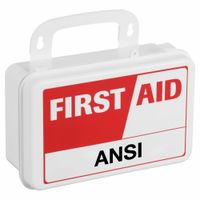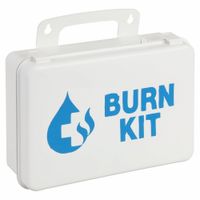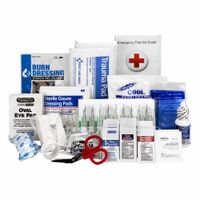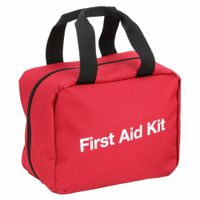Call +(254) 703 030 000 / 751 483 999 / 721 704 777
- Home
- Safety
- First Aid Wound Care
- First Aid Kits
.....Read More
Frequently Asked Questions
What items are included in an ANSI-compliant first aid kit?
An ANSI-compliant first aid kit, as per the ANSI/ISEA Z308.1-2021 standard, includes the following items:
1. **Adhesive Bandages**: Various sizes for minor cuts and abrasions.
2. **Adhesive Tape**: For securing bandages and dressings.
3. **Antibiotic Treatment**: To prevent infection in minor cuts and abrasions.
4. **Antiseptic**: For cleaning wounds to prevent infection.
5. **Breathing Barrier**: For providing CPR safely.
6. **Burn Dressing**: For treating minor burns.
7. **Burn Treatment**: To relieve pain and protect against infection.
8. **Cold Pack**: For reducing swelling and pain from injuries.
9. **Eye Covering**: For protecting injured eyes.
10. **Eye/Skin Wash**: For flushing out contaminants from eyes or skin.
11. **First Aid Guide**: Instructions for administering first aid.
12. **Hand Sanitizer**: For cleaning hands before and after treatment.
13. **Medical Exam Gloves**: To protect both the caregiver and the injured person.
14. **Roller Bandage**: For securing dressings and providing support.
15. **Scissors**: For cutting tape, bandages, or clothing.
16. **Sterile Pads**: For covering and protecting wounds.
17. **Trauma Pad**: For controlling bleeding from larger wounds.
18. **Triangular Bandage**: For creating slings or as a pressure dressing.
These items are categorized into four classes based on the intended use and workplace environment: Class A for common workplace injuries, Class B for more complex or high-risk environments, and additional specifications for workplace size and risk level.
How often should first aid kits be checked and restocked?
First aid kits should be checked and restocked regularly to ensure they are fully equipped and ready for use in emergencies. The frequency of these checks can depend on several factors, including the environment in which the kit is used, the size of the organization, and the specific regulations or guidelines applicable to the setting.
For most workplaces, it is recommended to check first aid kits at least once a month. This regular inspection helps ensure that all items are present, in good condition, and within their expiration dates. In high-risk environments, such as construction sites or manufacturing plants, more frequent checks may be necessary, potentially every two weeks, due to the higher likelihood of usage and the critical need for immediate access to first aid supplies.
In addition to scheduled checks, first aid kits should be inspected and restocked immediately after any use. This ensures that any items used during an emergency are replaced promptly, maintaining the kit's readiness for future incidents.
For personal or home first aid kits, a quarterly check is generally sufficient, unless the kit is used frequently or is exposed to conditions that might degrade its contents, such as extreme temperatures or moisture.
Regardless of the setting, it is crucial to maintain a checklist of the kit's contents and to train designated individuals to perform these checks. This ensures consistency and accountability in maintaining the kit's readiness. Additionally, keeping a log of inspections and restocking activities can help track usage patterns and anticipate future needs.
Ultimately, the goal is to ensure that first aid kits are always fully stocked and ready to provide immediate assistance in case of an emergency, thereby enhancing safety and preparedness.
What is the difference between a general purpose first aid kit and a trauma kit?
A general purpose first aid kit and a trauma kit serve different functions and are equipped accordingly.
A general purpose first aid kit is designed for everyday injuries and minor medical situations. It typically includes items such as adhesive bandages, antiseptic wipes, gauze pads, adhesive tape, scissors, tweezers, and over-the-counter pain relievers. These kits are suitable for treating cuts, scrapes, minor burns, insect bites, and other non-life-threatening injuries. They are commonly found in homes, offices, and vehicles, providing basic supplies to manage common accidents and ailments.
In contrast, a trauma kit is specifically designed to handle more severe and life-threatening injuries, often encountered in emergency or high-risk situations. Trauma kits contain advanced medical supplies such as tourniquets, hemostatic agents, chest seals, nasopharyngeal airways, pressure dressings, and trauma shears. These items are intended to control severe bleeding, manage airway obstructions, and stabilize critical injuries until professional medical help arrives. Trauma kits are often used by first responders, military personnel, and in environments where there is a higher risk of serious injuries, such as construction sites or remote locations.
In summary, the primary difference lies in their intended use and contents: general purpose first aid kits are for minor injuries and everyday use, while trauma kits are equipped for serious, life-threatening emergencies.
How do I choose the right first aid kit for my workplace?
To choose the right first aid kit for your workplace, consider the following factors:
1. **Workplace Size and Layout**: Assess the number of employees and the size of the workplace. Larger spaces or those with more employees may require multiple kits.
2. **Industry and Hazards**: Identify specific risks associated with your industry. For example, construction sites may need kits with more trauma supplies, while an office might require basic supplies.
3. **Regulatory Requirements**: Check local regulations and industry standards for first aid kits. Compliance with OSHA or other relevant bodies is crucial.
4. **Kit Contents**: Ensure the kit includes essential items like bandages, antiseptics, gloves, scissors, and CPR masks. Tailor contents to address specific workplace risks.
5. **Accessibility and Visibility**: Place kits in easily accessible and visible locations. Ensure all employees know where they are and how to use them.
6. **Training and Instructions**: Provide training for employees on first aid procedures. Include a manual or instructions in the kit for quick reference.
7. **Restocking and Maintenance**: Regularly check and restock the kit. Assign responsibility to a specific person or team to ensure it is always ready for use.
8. **Customization**: Consider customizing the kit based on unique workplace needs, such as including burn treatment supplies for kitchens or eyewash for laboratories.
9. **Quality and Durability**: Choose kits made from durable materials to withstand workplace conditions. Ensure items are of high quality and not expired.
10. **Budget**: Balance cost with quality and comprehensiveness. Investing in a good kit can prevent more costly medical emergencies.
By evaluating these factors, you can select a first aid kit that effectively meets the needs of your workplace, ensuring safety and compliance.
What are the essential items in a burn care kit?
A burn care kit is essential for providing immediate and effective treatment for burn injuries. Key items include:
1. **Sterile Saline Solution**: Used for cleaning the burn area to prevent infection.
2. **Non-stick Sterile Dressings**: Protects the burn without sticking to the wound, allowing for easy removal and reducing pain.
3. **Hydrogel Burn Dressings**: Provides cooling relief, reduces pain, and helps in the healing process by keeping the burn moist.
4. **Burn Ointment or Cream**: Contains ingredients like aloe vera or lidocaine to soothe and protect the skin.
5. **Antibiotic Ointment**: Prevents infection in minor burns.
6. **Adhesive Bandages**: For covering small burns and blisters.
7. **Medical Tape**: Secures dressings in place without causing further irritation.
8. **Scissors**: For cutting dressings and tape to the appropriate size.
9. **Tweezers**: Useful for removing debris from the burn area.
10. **Pain Relief Medication**: Over-the-counter options like ibuprofen or acetaminophen to manage pain and inflammation.
11. **Gloves**: Disposable gloves to maintain hygiene and prevent infection during treatment.
12. **Instant Cold Packs**: Provides immediate cooling to reduce swelling and pain.
13. **Burn Relief Gel**: Offers immediate cooling and pain relief.
14. **Emergency Contact Information**: Important for seeking professional medical help if needed.
15. **Instruction Manual**: Provides guidance on how to treat different types of burns effectively.
These items ensure that you can provide immediate care to minimize damage, reduce pain, and prevent infection until professional medical treatment is available.
How do I properly store a first aid kit?
To properly store a first aid kit, choose a cool, dry location that is easily accessible to all household members but out of reach of young children. Ensure the kit is clearly labeled and stored in a durable, waterproof container to protect contents from moisture and damage. Regularly check the kit to replace expired items and replenish used supplies. Keep a list of contents taped inside the lid for quick reference. Store the kit away from direct sunlight and heat sources to prevent degradation of materials. If the kit is for a vehicle, secure it to prevent movement during transit.
What should I do if my first aid kit housing is damaged?
If your first aid kit housing is damaged, you should take the following steps:
1. **Assess the Damage**: Determine the extent of the damage to the housing. Check if it affects the contents' protection from moisture, dust, or contamination.
2. **Transfer Contents**: If the damage compromises the kit's integrity, transfer the contents to a temporary, clean, and dry container. Use a sealable plastic bag or a sturdy box to ensure the items remain protected.
3. **Inspect Contents**: While transferring, inspect each item for damage or expiration. Replace any compromised or expired items to maintain the kit's effectiveness.
4. **Choose a New Housing**: Select a new, durable container for your first aid kit. Consider factors like size, portability, and material. Options include hard plastic cases, metal boxes, or waterproof bags.
5. **Organize the Kit**: Arrange the contents in the new housing for easy access. Use compartments or dividers if available to keep items organized and prevent damage.
6. **Label the Kit**: Clearly label the new housing as a first aid kit. Include a list of contents and emergency contact information for quick reference.
7. **Store Properly**: Place the kit in a location that is easily accessible in emergencies but protected from extreme temperatures, moisture, and direct sunlight.
8. **Regular Maintenance**: Schedule regular checks to ensure the kit remains complete and in good condition. Replace used or expired items promptly.
9. **Educate Users**: Inform family members or colleagues about the new location and contents of the first aid kit to ensure everyone knows how to access and use it in an emergency.






